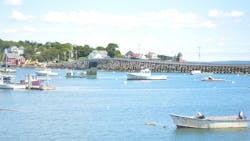By: Bruce A. Van Note
Maine’s 3,478-mile-long coastline plays a fundamental role in our state’s identity as well as its economy.
The lobsters hauled into our working waterfronts are our most valuable export. Millions of tourists visit our sandy beaches, rocky cliffs, and idyllic islands every year. While all these features enhance the quality of life here, the unpredictable and unrelenting nature of the ocean presents a unique situation for the Maine DOT (MaineDOT). There are constant logistical, environmental, and financial challenges associated with maintaining our coastal assets, which include roads, bridges, and ferry terminals.
Roads
Sixteen of Maine’s island communities are either stand-alone towns or part of mainland municipalities. All these communities receive varying levels of state funding for capital improvements of local roads. Four Mid-Coast islands (Islesboro, North Haven, Swan’s Island, and Vinalhaven) have state aid roads. On those roads, MaineDOT is responsible for all summer maintenance, while municipalities perform all winter maintenance, including snow plowing.
Maintaining island roads involves logistical and financial challenges. Moving crews and equipment between the mainland and the islands requires coordination with ferry schedules. The four islands with state aid roads are all served by the Maine State Ferry Service. The MSFS is a lifeline, facilitating the movement of both people and supplies every day of the year, so space for construction crews is often limited. Paving contractors have very limited private transport options to move equipment and materials. These factors complicate MaineDOT’s ability to respond quickly to emergency maintenance situations on these islands.
This year, MaineDOT is scheduled to pave 68 miles of roads in coastal communities in Hancock County (southeast of Bangor). The department will be paving in municipalities that include Bar Harbor, Mount Desert, Southwest Harbor, and Tremont. These communities are near both Acadia National Park—one of the most visited national parks in the country—and other popular summer destinations. MaineDOT workers and contractors must consider the added tourist congestion when coordinating road work. Service vehicles and crews can crowd narrow roads. We always try to pave these project locations as early or as late as possible in the construction season to avoid the heavy tourism crush.
Bridges
Maine has several unique coastal bridges. Among them is the Bailey Island Bridge, commonly called the Cribstone Bridge. It connects Bailey Island to Orr’s Island in Harpswell—11 miles south of Brunswick on the northeast side of Casco Bay. First opened to traffic in 1928, this bridge is the last free-standing, dry-laid granite bridge in the world. While the deck is concrete, there is no concrete or grout in the substructure, just slabs of locally sourced granite stacked in a crisscross pattern. The granite is heavy enough to withstand the wind and waves, while the design allows the tide to ebb and flow through the structure. The Cribstone Bridge is on the National Register of Historic Places and recognized as a Historic Civil Engineering Landmark.
For nearly a century, the Cribstone Bridge has weathered hurricanes and ice storms, not to mention the salty environment that would wreak havoc on concrete, iron, and steel. MaineDOT replaced about 200 granite slabs during a restoration project that was completed in 2010. Ongoing maintenance of the Cribstone Bridge is an up-close-and-personal effort for department staff. Following high winds and tides, maintenance workers walk the 1,150-ft-long bridge. Debris that makes its way into the bridge’s open spaces can be especially harmful to the structure; a log can act like a battering ram when the water is high. A bad storm can knock as many as a half dozen stones loose.
Another one-of-a-kind bridge asset in Maine is the Penobscot Narrows Bridge and Observatory (PNBO). The cable-stayed structure carries Route 1 over the Penobscot River between Prospect and Verona Island (south of Bangor). The new structure opened in 2006 and includes the tallest public bridge observatory in the world.
PNBO replaced the Waldo-Hancock suspension bridge, which was built in 1931. In 2003, inspectors found heavy corrosion in the old bridge’s main cables. MaineDOT broke ground on the new bridge five months later. Protecting the new bridge’s cable stays was a high priority for the department. The galvanized steel strands on the new bridge are coated with flowfill epoxy. Six of the cable stays use carbon fiber strands that will not corrode the way that steel does; this is especially important in a coastal environment. The cables are sheathed in hard plastic protective tubes that are filled with an inert gas, which eliminates all oxygen from the environment and allows engineers to monitor the internal pressure to ensure there are no leaks.
During some winter weather events, dangerous amounts of ice have formed on the PNBO’s cable stays. This has prompted the department to close the bridge to traffic on three separate occasions since the bridge first opened. Any closure of the bridge results in a 34-mile-long detour for Route 1 travelers. Engineers and maintenance staffers have explored options for dealing with forming and falling ice and determined the best way to remedy the problem is the simplest one: close the bridge and wait for the ice to fall.
Ferry Terminals, the Environment, and $
MaineDOT funds half the operational expenses and all the capital expenses of the Maine State Ferry Service, which serves vehicles and passengers to six islands. The electrical and mechanical parts of the ferry transfer bridges sit in a highly corrosive environment that experiences extreme temperatures. Workers have had to go out in the dead of winter to melt foot-thick ice build-up on ramps to preserve ferry service to the islands. In the summer, hydraulic issues present in the form of blown hoses and bound-up motors on these moveable bridges. Most ferry routes are in use multiple times each day, so it can be challenging to schedule work windows that allow significant maintenance and improvement work while still serving ferry customers.
Ensuring infrastructure resilience is an important part of MaineDOT’s planning. National Oceanic and Atmospheric Administration (NOAA) historical data show the sea level along the Maine coast is rising between 0.5 and 0.75 ft every 100 years. Based on these data and NOAA projections, MaineDOT’s proposed designs now assume 4 ft of sea level rise on all coastal projects. Elevation is the key to ensuring coastal resilience. For bridge work, that often results in longer approaches, which can impact nearby properties.
Moreover, the cost of doing business to provide coastal communities with the best transportation infrastructure system possible is more expensive than it is in inland locations. Some marine work (especially underwater rock drilling) is complex and expensive. There are not a lot of contractors in Maine that own and thus can employ the use of barges and are willing to work in challenging environmental conditions. Some work has winter in-water work windows—that means the contractor is working in cold, rough weather. Lack of competition can result in higher bid prices.
The biggest financial challenge MaineDOT is facing is something that affects all work—not just work on coastal assets. Earlier this year, a bipartisan group pegged the department’s chronic unmet funding need at $232 million annually. That is after the passage of a $100 million bond. Declining statewide traffic volumes during the COVID-19 pandemic have directly impacted fuel revenues, further stressing available resources. Until there is a fundamental change in the way our state pays for its infrastructure, the dedicated and hardworking men and women of MaineDOT will be left to competently manage the slow decline of Maine’s transportation system.
Declining statewide traffic volumes during the COVID-19 pandemic have directly impacted fuel revenues, further stressing available resources. The number of vehicles traveling Maine roads dropped by about half in late March 2020. Volumes have rebounded, but as of the beginning of our state’s peak tourist season, they were still down by double-digit percentages. Current estimates indicate a $56 million drop in Highway Fund revenue in the 15 months following the onset of the pandemic. MaineDOT is bracing for an 11% drop from pre-pandemic predictions in the 2020/2021 fiscal year—which will be the deepest and most sudden drop of Maine’s Highway Fund revenue in memory.
While MaineDOT engineers, crewmen, and staff persist in the heroic work of smartly applying available resources in order to meet the demands of our residents, challenges will continue.
About The Author: Van Note is Commissioner of the Maine DOT.








